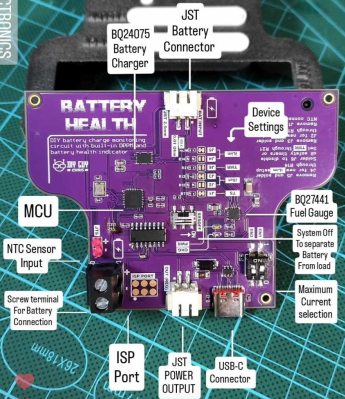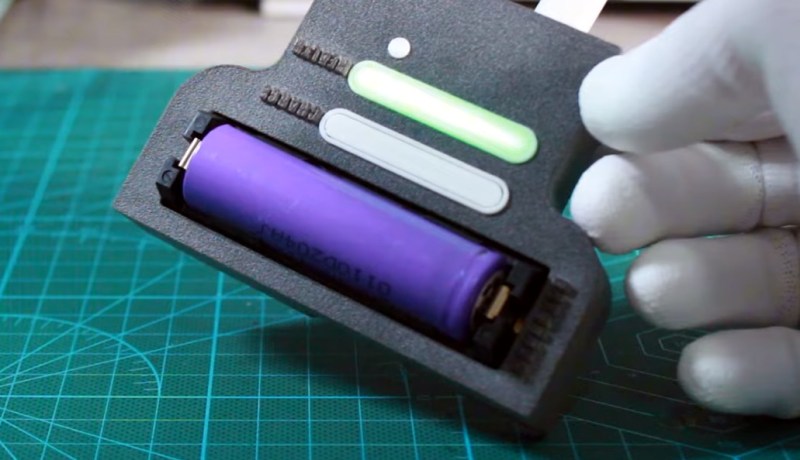You can salvage lithium 18650 cells from all sorts of modern gadgets, from disposable vapes to cordless power tools. The tricky part, other than physically liberating them from whatever they are installed in, is figuring out if they’re worth keeping or not. Just because an 18650 cell takes a charge doesn’t necessarily mean it’s any good — it could have vastly reduced capacity, or fail under heavy load.
If you’re going to take salvaging these cells seriously, you should really invest in a charger that is capable of running some capacity tests against the cell. Or if you’re a bit more adventurous, you can build this “Battery Health Monitor” designed by [DIY GUY Chris]. Although the fact that it can only accept a single cell at a time is certainly a limitation if you’ve got a lot of batteries to go though, the fact that it’s portable and only needs a USB-C connection for power means you can take it with you on your salvaging adventures.
 The key to this project is a pair of chips from Texas Instruments. The BQ27441 is a “Fuel Gauge” IC, and is able to determine an 18650’s current capacity, which can be compared to the cell’s original design capacity to come up with an estimate of its overall health. The other chip, the BQ24075, keeps an eye on all the charging parameters to make sure the cell is being topped up safely and efficiently.
The key to this project is a pair of chips from Texas Instruments. The BQ27441 is a “Fuel Gauge” IC, and is able to determine an 18650’s current capacity, which can be compared to the cell’s original design capacity to come up with an estimate of its overall health. The other chip, the BQ24075, keeps an eye on all the charging parameters to make sure the cell is being topped up safely and efficiently.
With these two purpose-built chips doing a lot of the heavy lifting, it only takes a relatively simple microcontroller to tie them together and provide user feedback. In this case [DIY GUY Chris] has gone with the ATmega328P, with a pair of addressable WS2812B LED bars to show the battery’s health and charge levels. As an added bonus, if you plug the device into your computer, it will output charging statistics over the serial port.
The whole project is released under the MIT license, and everything from the STL files for the 3D printed enclosure to the MCU’s Arduino-flavored firmware is provided. If you’re looking to build one yourself, you can either follow along with the step-by-step assembly instructions, or watch the build video below. Or really treat yourself and do both — you deserve it.
If your battery salvaging operation is too large for a single-cell tester, perhaps it’s time to upgrade to this 40-slot wall mounted unit.
















Missing a critical parameter => Internal Resistance !
The BQ27441 on the board measures internal resistance – that’s one of the key ways it determines battery health (along with temperature, coulomb counting, and some mysterious secret sauce). I don’t think the chip provides a way to directly report any thing besides state of charge and an opaque “state of health” to the end user, though.
As a quick initial “go/no go”, this seems like a fine option, at least if you run it with an appropriate test load.
I mean, personally I’d rather just have all the numbers instead of trusting TI’s secret algorithm, but there’s plenty of evidence out there that it works.
Ya, I’d personally want an isr number, because where it’s ‘good’ will depend a lot on the type of cell. I.e. is it a power tool cell rated to 35 amps, or is it a light load high cap cell that’s only rated to 3A or so. Almost all that difference is the manufactured isr of the cell. A power tool cell could read good at a couple amps, but not be suited to the types of very high currents you’d want to use it for.
So, is this a charger that logs the capacity? As far as I can tell, it doesn’t measure internal resistance with a load test, which is the first test I do for questionable cells; it gives you the best quick indication for the health of the cell.
If it fails under load, it usually doesn’t have any useful capacity left, and if it passes, the capacity may be significantly lower than a new cell, but usually still at a useful level, especially if you use cells individually or in parallel; using old cells in series is generally a bad idea.
I haven’t studied the schematic, but the article says it measures the cell’s current capacity, which, as I understand it is completely linked to its internal resistance (since you’re modeling a battery as a voltage source with a series resistance, the series resistance gives the possible current draw you can do). As far as I know, it’s what you want, no?
I think they meant “current capacity” as in “capacity at the current moment”, not current (I).
anyway, you’re correct that V=IR, of course, but that’s not usually the limiting factor. in the real world you also have to deal with a lot of other problems, like the rate at which chemical reactions actually occur (and can occur without damaging the battery). And of course increased resistance = increased heat, which isn’t just exciting because of the potential for thermal runaway, but because heat itself changes internal resistance.
Parrot-scale measurements
Not the same, but I bought a cheap batteries tester some time ago.
Since it’s Chineseum, I’d to change a couple of resistors to make it measure precisely, add a little resistor in parallel to have a bit of consumption while measuring to help discard weak ones.
After that I made myself a pretty 3D printed case for it, ready to be bolted to a cabinet door where I already have some 3D printed batteries supports.
Now I can readily test my batteries before using them, as I can fast and reliably test some used batteries before putting in the storage.
Not the same, but I bought a cheap batteries tester some time ago.
Since it’s Chineseum, I’d to change a couple of resistors to make it measure precisely, add a little resistor in parallel to have a bit of consumption while measuring to help discard weak ones.
After that I made myself a pretty 3D printed case for it, ready to be bolted to a cabinet door where I already have some 3D printed batteries supports.
Now I can readily test my batteries before using them, as I can fast and reliably test some used batteries before putting in the storage.
Your modifications would make and interesting article for Hackaday!
It’s a good start, but i would extend it with some different discharge resistors, to actually measure voltage drop under some load conditions. And if you have that, add a “ready for storage” option that only charges the cells to around 70% or discharges them to that level.
And i would probably prefer a little graphics display to show actual values, and not just some color bars.